With computer audio being popular enough to practically be ubiquitous, external USB DACs are the order of the day. More options exist, at more price points, than ever before. Sure, some of them are crap, but many are pretty respectable, and a few are downright fantastic. We have become spoiled for choice – whether you want a pocket-sized transportable wonder or a multi-box megasystem, there are good choices in every size and price range.
But how much to spend? How can I get the most for my money without overdoing it? It’s a question I get asked a lot these days. There are a few ways to approach the topic, all of which have some merit, but none of which is perfect by itself.
The first way is the classic audiophile fallacy – spend as much as possible to get the nicest DAC you can afford. This will probably get you something that doesn’t suck, but it doesn’t protect you from spending way too much on something that doesn’t necessarily have the best price to performance ratio. It’s easy to overspend when you don’t do your homework.
The next option, a common formula, is the arbitrary percentage. Take the total budget and break it into sections: something like 30% speakers, 30% amplification, 30% source, and the remaining 10% on cables. This has the advantage of keeping things in some kind of proportion, though it doesn’t really account for synergy between the components. And how do we know those ratios are even correct?
The third method is one I’m seeing more of lately, and to some extent I agree with it. This one says you should not go all out on a digital source these days. It’s a relatively new field. Advances are happening far more rapidly than they are in other categories. So a flagship DAC will become obsolete (or merely “good” instead of “great”) far more quickly than a similarly high-end loudspeaker or preamp. Thus, spending a fortune doesn’t make much sense. Why mess around chasing that last few percent worth of sound quality which comes at such an obscene cost? Just grab the latest $2,000 device and call it a day, then be prepared to repeat the process every three or four years. This one makes sense until you discover that yes, there are indeed a few options exceeding that price cap which offer a significant enough performance boost to possibly justify their price.
My Way…
I propose a careful synthesis of all three methods. To that end, my reference DAC (and the topic of this review) is the Resonessence Labs Invicta Mirus. At $4,999 it’s certainly not a budget device. Nor does it cost more than a new BMW, as more and more top DACs seem to do these days. What it offers is very high functionality, with exceptional sound quality, all for a price which is in line with many of my other components. For me, an essentially perfect DAC, and I suspect it will fulfill that same role for a good many other people too.
Resonessence Labs has their roots in ESS Technologies, makers of the popular Sabre series of DAC chips. Mark Mallinson, head man at Resonessence, was formerly director of operations at ESS. Several other Resonessence engineers were key players at ESS as well, which means the team is designing a device around their own chips – a recipe for success if you ask me. I’ve heard multiple designers complain about the Sabre chips and how difficult they can be to work with. Folks seem to have a handle on it by now (based on the high number of quality DACs using Sabre chips these days), but it remains a logical assumption that the Resonessence team would have a unique ability to extract the maximum performance from their own creations.
Mark Mallinson says it like so:
“With our unique understanding of the Sabre DACs we have been able to fine tune their performance to, in some cases, outperform the published specs of the parts themselves. No expense has been spared to optimize the Sabre DACs in Invicta. Many of the tricks and techniques that we have employed are buried in our firmware. It is for others to judge how good of a listening experience the Invicta unit is, but we are confident that there is not a better implementation of the Sabre DAC in a system level product.”
For a bit of background, let me explain the genesis of the Invicta Mirus. Initially, the product was simply called Invicta and it launched back in 2011. It won significant praise from a variety of publications and put Resonessence Labs on the map in the high-end space. In the years that followed, the team was constantly refining their product, launching update after update to the firmware. Some of these were bug fixes, down to some extremely small bugs that only appeared under very specific circumstances. Others were new configuration options, prompted by requests from end users – an example would be the ability to independently dim the OLED screen and the various LED indicators. Resonessence takes customer feedback more seriously than perhaps any other firm I’ve encountered. But more importantly, many of these updates enabled new functionality that had been unheard of when the device was first conceived. This is thanks to the powerful FPGA (Field Programmable Gate Array) on board. I’ll spare you the entire history lesson but we’re talking dozens of improvements, of which several were very notable. Things like DSD capability, balanced headphone drive, and significantly improved sound quality are certainly welcome additions to receive a year or two after initial purchase.
Last year, the company did a complete overhaul of the Invicta, improving various internal aspects and splitting it into two distinct sub-devices. The Invicta continues, keeping its on-board headphone amplification, while Invicta Mirus omits that section and throws all its processing power towards the line-out. Both models sell for the same price and look nearly identical.
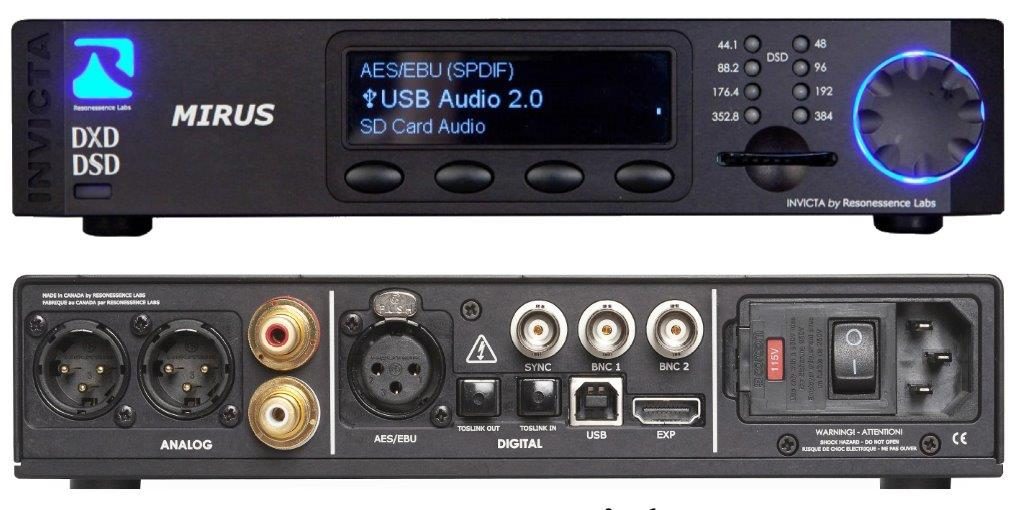
Design…
Invicta is a relatively compact unit measuring roughly than 9 inches wide, 11 inches deep, and 1.75 inches high. It features a prominent OLED display front and center, flanked by various buttons, LED indicators, and a multifunction rotary knob. Build quality is extremely high but the focus is squarely on function rather than audiophile bling. Remote duties are handled through a repurposed Apple remote which I feel is a better choice than the dedicated wand they used to include – it’s hard to beat Apple for design.
The first thing that might catch your eye is the SD card slot – why on earth would a DAC need an SD card slot? Well, Invicta is more than “just a DAC”, and the SD slot is actually a key feature. Insert an SD card loaded with your favorite music and Invicta will play it back, acting as both DAC and high-end transport. The player will accommodate most popular file types such as FLAC, AIFF, and WAV, up to 24-bit/384kHz, as well as DSD64 and DSD128 files in either DSF or DFF format. Rather than thinking of the device as a DAC with an SD card reader tacked on, it’s more appropriate to picture Invicta as an all-encompassing platform. The entire datapath chain is custom designed and implemented in the FPGA. A Resonessence Labs engineer puts it like so:
“We designed the SD card controller at the logic level. What this means is we have 100% control of the dataflow all the way from the SD card, including the method of data transfer, how it’s buffered and streamed to the DAC. Since we wanted to have the audio quality as our priority, we make sure that the SD card read rates are not just the same as the average data rates, but we also stream the data in a smooth fashion as we control the entire chain.
What this means is that we don’t “burst” data from the card, then dump into a FIFO to filter the average rate out. We make sure that the FIFO is being filled and emptied more or less constantly. Why this is important is that the bursts of data actually tax the power supply system and can bleed into the analog supplies, This is same process that you may have heard in a laptop when you move your mouse, for example, and can hear the audible effects. The other thing is that contrary to what some marketing people say (not just in audio circles), the SLOWEST transfer to get the job done is often the BEST. The slower the transfer, the lower the RF energy is spewed into the circuit board, the less chance it can contaminate any audio signal or power system. This is actually why we offer both USB 1.0 and 2.0 on our flagship. If all you use is up to 24-bit/96kHz, the USB 1.0 is more than sufficient, and it does a great job.”
In the spirit of humility, he goes on to add:
“I want to also make the disclaimer that a well designed SD card source from the standard chipsets can also have its noise tamed as long as the designer is astute. I assume most HiFi audio designers have good practices so to claim we are simply “better” because we wrote our own is a little misleading. It is simply our methodology of addressing any potential issue at the source instead of adding mitigation tactics after the fact taken to the extreme.”
He’s being modest, which is never a bad attitude to have, and to some degree I think it defines Resonessence Labs as a company. Some of the things they do are totally unique in the Hi-Fi space, and yet they prefer to let the results do the talking. How many times have you rolled your eyes at some press release or advertisement, when the marketing team takes a relatively common feature, gives it a catchy name, and makes it out to be the holy grail of audio reproduction? Contrast that with Resonessence Labs who wrote their own GPU for connecting Invicta to an external monitor, just to keep from adding more non-audio-related chips in the system…. yet never bragged about it? It’s an approach I can definitely get behind.
In addition to being a transport and a DAC, Invicta also features their high-end digital volume control implementation. This means it can drive an amplifier directly. Using CD quality (16-bit) material, Invicta can attenuate at least 35dB without any loss of resolution. This makes for a legitimate alternative to using an external preamp, with the resulting signal path being that much more direct. Some folks will refuse to give up their favorite preamp which of course is a valid option as well.
Inputs and outputs are myriad. All the expected formats are accounted for along with some unconventional ones like HDMI (used for connecting a monitor to better navigate SD card contents) and Toslink output (allowing the SD card player to act as transport to another DAC). AES/EBU, Toslink, and BNC inputs can all accept DSD (in DoP form) thanks to a recent firmware update. Apparently that was something users wanted, and thanks to the highly configurable platform the team could easily make the change. How convenient.
Particular attention was paid to the USB input, and it’s worth talking about for a minute since that’s probably the most commonly used option these days. Resonessence Labs uses a USB solution from Cypress Semiconductor that, to my knowledge, is not found in competing products from any other brand. While some devices license USB implementations from Gordon Rankin (Wavelength Audio) or CEntrance, and others use existing solutions from XMOS, VIA, C-Media, etc, Resonessence Labs writes their own code from scratch and uses a combination of FGPA plus Cypress chip for the execution, giving them full control of how the data is handled. This is kind of a big deal – there are very few players in the DAC space capable of attempting this sort of endeavor. Factor in the SD card reader design I discussed earlier, and their custom developed filters, and you can see how the Invicta offers a unique experience. And I’d say it really pays off…. but more on that later.
The Split…
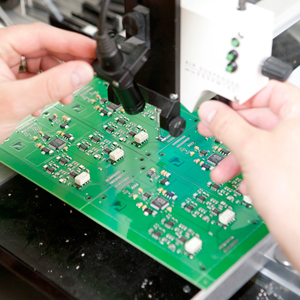
This is where the Invicta and Invicta Mirus diverge. The original model used a flagship ESS ES9018 Sabre DAC for the line-out and a separate ES9016 for the headphone section. The refreshed Invicta bumps up to an ES9018 for headphone duty, while Invicta Mirus throws two ES9018 chips at the line-out in lieu of the missing headphone section. ES9018 is an 8-channel design so the Invicta applies 4 per side for the left and right outputs, which is referred to as quad-mono operation. The Mirus has two ES9018s for the stereo output so it’s like having 8 DACs per channel, which we could call…. Octa-Mono? Pretty catchy I’d say. Much more catchy than “16 DACs on board” or “8 DACs per channel”, which might be a little confusing considering there are only two physical DAC chips involved. Hopefully you get the point.
Having lived with the original (non-Mirus) Invicta for a long time, I can heartily recommend it on the strength of its integrated headphone section. The built-in SD card reader plus headphone amp means you get a compete headphone playback system from start to finish – nothing else is needed short of the obvious power cable and wall plug requirements. And the headphone amp is no mere afterthought – I found it to be of extremely high quality, only surpassed by some of the absolute best stand-alone amps on the market. That said, I do understand why the Invicta Mirus exists. A headphone lover in the market for a $5,000 DAC is likely to have their own top of the line headphone amplifier. Or maybe several. So despite the integrated amp section being very good, the truly serious headphone enthusiast – myself included – is probably better served by the Invicta Mirus.
Listening…
My first experience with the Invicta Mirus was that of extreme detail, combined with a very natural sense of realism. That’s a combo which doesn’t always go together. This DAC absolutely stunned me with its unforced clarity and big, accurate soundstage. Honestly I wasn’t expecting all that much improvement over the original Invicta – I don’t know how much of this change is due to the recent overhaul, or how much is caused by this being the Mirus version. Whatever the case, I was off to a great start.
In my experience, however. first impressions aren’t worth all that much. I hate to admit it, but often times I find that my expectations are colored (for good or for bad) by the price tag, the appearance, or even the brand name of the device. I’ll give it a listen, make some mental notes, and then just leave it alone for a long time to accumulate some hours and “burn in”. Do I necessarily believe in the sound changing significantly after 50 or 100 or however many hours of operation? Not really. It could happen, I suppose, but it’s not really high on my list of things that matter. But I find when I have the thing sitting there for a week or two, and I’ve been staring at it and occasionally popping in to listen, my expectations change. The excitement (or possibly the disgust) of the price tag, the looks, the pedigree, has died down as the thing became a fixture in my living room. At that point I basically go back and start over with a clean slate, ready to completely disregard my initial impressions if need be.
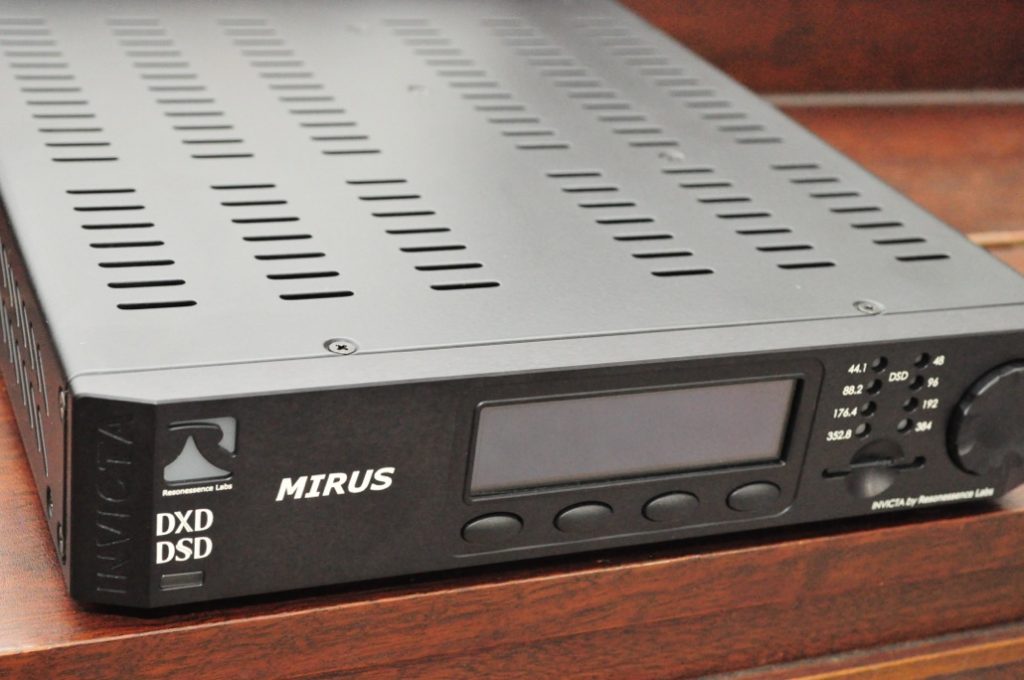
This was one of those times where my fresh start brought me right back to the same place. The Invicta Mirus really was that good. I listened with my highly revealing HD800, my bombastic LCD-3, my ultra-neutral Stax SR-4070, and my smooth, organic Noble Kaiser 10. With each setup, I found myself thinking the amp and/or headphones was more of a factor in the resulting sound as compared to the DAC. I had crossed the threshold that only the best sources cross, where I felt things to be exceedingly transparent. The Invicta Mirus was so good that it forced the spotlight away from itself and onto the supporting gear, the recording, and the ability of my brain to discern what I was hearing. In short, the DAC was quite simply one of the best I had ever heard, at any price.
Some music examples to help flesh out what I’m trying to explain. I’m a big fan of Colombian singer/songwriter Marta Gomez. I find her songs to have just the right mix of complexity and accessibility, often times having subtle layers of dense rhythms hiding in a seemingly basic groove. I also find her voice ravishing in a very non-obnoxious way. Anyone who’s spent time at an audio show knows how old it gets hearing the same Rebecca Pidgeon and Diana Krall “audiophile” tracks. As nice as the recordings might be, a lot of that stuff becomes nails on a chalkboard after you’ve heard it a few times in a row, or dozens of times cumulatively. Marta Gomez, to these ears, holds up far better, and really deserves to be blasting on some $150k system at a big show.

All of Marta’s albums seems to be pretty well recorded. My favorites are Cantos de Agua Dulce (2004) and Entra Cada Palabre (2006), both of which happen to be available as 24-bit/96kHz downloads. These two were recorded by Chesky at Saint Peter’s Church in New York, to their typical high standards, and they stand out among the rest of her albums as being truly reference quality. Invicta Mirus plus a top level headphone system allowed me to hear unbelievably deep into the recording. The reverberation from the large church setting, the interplay between percussionist and bassist, the sweetness of those vocals… Invicta Mirus brought it all out with breathtaking clarity. It’s the type of thing where I don’t even want to keep notes – I just want to listen and forget about the whole reviewing thing. Then something happened… despite me going with the flow, and feeling almost like I wasn’t giving much of a critical listen at all, I noticed a slight difference which I had never spotted before. I was able to discern a small but clear distinction in the vocals from one album to the next.
On Cantos de Agua Dulce, Mart’s voice is up front and intimate, with an almost spooky-real sense of presence to it. On Entra Cada Palabre, she seems to have taken a step back away from the microphone. This time she sounds more distant, more diffuse, and thus further back with her supporting musicians – on the prior album she was clearly standing farther out in front. Now, I don’t have pictures of their recording sessions so I can’t speculate if this actually happened or not. Maybe it comes down to a difference in microphone placement, or even just the recording and mastering process. Regardless, that’s the stage as presented by the Invicta Mirus, and it’s utterly convincing. I’ve listened to these albums back to back dozens of times over the past decade or so, and never spotted this. Now that I’m aware, of course I can hear it with other gear too – but Invicta Mirus was the first to call it to my attention, and still does the best job of bringing it out. All this when I could have sworn I was merely enjoying the tunes and not paying attention for that sort of thing.

Moving on to some classical – as much as I love solo piano works and chamber music, there’s nothing quite as satisfying as large scale, bombastic pieces for testing the sheer dynamic capabilities of an audio system. It’s just downright exciting to listen to on a quality setup. I defy anyone who thinks classical as a genre is stuffy or boring to play Holst’s “Mars, Bringer of War” at high volumes on a good system. Their opinion will surely be changed by the end of that experience. Two of my favorite tracks of this nature are both found on the same release: the Reference Recordings HRx Sampler. This is a must-have disc for anyone wanting to build a collection of reference, hi-res material. Their HRx “format” is really just extremely high bitrate PCM in 24-bit/176.4kHz form, so it should work with most any modern DAC – even one that doesn’t have the latest DSD capabilities. The tracks in question are Respighi: Belkis, Queen of Sheba Suite – War Dance and Stravinsky: The Firebird Suite – Infernal Dance, with Eiji Oue conducting the Minnesota Orchestra. Both of these tracks have absolutely crushing dynamic swings and movements that can really point out flaws in a system. The Invicta Mirus handled them better than perhaps any DAC I’ve yet experienced in my setup.
People talk a lot about headphones and how (generally speaking) they deliver higher resolution than comparably priced speakers. I won’t argue that point, but I do think there’s more to it than that, and perhaps this other aspect is even more important. When it comes to detail, one can do quite well for themselves with a good pair of standmount speakers in the $500-1500 range. Can you match the performance of headphones? I suppose it depends on your room acoustics. However, I’m fairly certain you won’t be able to match the full range sound of a good pair of cans. Those standmount monitors will roll off heavily at around 50Hz, or maybe 40Hz if you’re lucky. Will you get true, full range response from 20Hz to 20kHz? Nope. And the higher your volume creeps, the more you’ll notice this struggle to reproduce the full scale of the performance. But headphones won’t have that issue. Play back the above mentioned HRx tracks and you’ll get a great example of this. I can grab my Audeze LCD-2 or Westone ES5 or HiFiMAN HE-6 and play these tracks at absurd levels without losing composure. Mind you, all of these models fall in that same $500-1500 price range.
My point in all this? A good headphone system will make demands on the DAC that a comparably priced speaker system will not. Invicta Mirus allows me to hear these performances at volumes similar to that of a live performance, maintaining an iron grip on the low frequencies and really allowing those huge dynamic contrasts to shine through effortlessly. It’s good enough to where I notice the Sennheiser HD800 and the beyerdynamic T1, based on dynamic driver technology, falling behind their planar magnetic competition from Audeze and HiFiMAN. That dynamic duo may do other things better, but the planars surely have a corner on the market when it comes to reproducing a massive sense of scale. I’d have to spend huge amounts of money on room treatments, speakers, and amplification to bring my speaker-based rig up to this same level of competency.
Another thing I like about the Invicta Mirus is that it’s not one of those ultra-picky, trailer-queen DACs that won’t play well with anything less than ideal recordings. There’s a large number of albums in my collection which I really enjoy in spite of their pedestrian or even downright poor quality. Examples include the self-titled release from Sister Sparrow and the Dirty Birds, as well as The Moon is Down by Further Seems Forever. These two both have a similar problem in that they sound dull and muffled on the top end, likely a result of budgetary constraints – neither band was likely to become a huge commercial success, and the record companies surely knew that going in. Still, the music is good, and I want to be able to make the most of it.
Other DACs such as the Esoteric D-07X (priced similar to the Invicta) make this stuff sound flat and etched to the point where I don’t enjoy listening for long. The Invicta Mirus handles these types with a sense of grace and fluency not easily found – the last few DACs I owned with similar abilities were the Wavelength Cosecant and the MBL 1511E. As much as I loved those two, neither had the same level of sophistication as the Invicta, and neither dug as deeply into the sonic landscape. I wouldn’t call them overly smooth or dark, but they did have a sense of “roundness” for lack of a better word. Certainly fun to listen to and I enjoyed my time with each one, but by today’s standards neither would qualify as a top dog. So what we end up with here is the best of both worlds, a DAC which can carve out the innermost detail on a quality recording, without butchering the less fortunate tracks. Musicality and resolution in perfect harmony. Yummy.
To illustrate this concept even more, I went even further down hill to the decidedly grimy None Shall Pass by vocal gymnast Aesop Rock. His gritty beats, trademark gravel-ridden voice, and nigh-impenetrable lyrical flow are not what you’d typically think of using to evaluate a piece of audiophile gear, but again – are we really all about the music, or what? If so, I really don’t think we should be required to shy away from stuff we enjoy just because it doesn’t sound like a sonic pearl. I wanted to enjoy my favorite tracks like “Catacomb Kids” and “Bring Back Pluto”. So I used the Auralic Taurus mkII and the Audeze LCD-3 and guess what? I loved the pounding basslines and clever wordplay. There’s a certain “bounce” to it, where lyrics are delivered in such a way as to become part of the rhythm along with the actual drum beat. Does anyone actually need a $5k DAC to play this sort of stuff? Of course not. But you should be able to do it if you want. I switched to the Esoteric D-07X and again didn’t enjoy it nearly as much, as all it seemed to do was draw attention to the flaws. The soul, the bounce, was just missing, and what was left over wasn’t really worth hearing. Too bad.
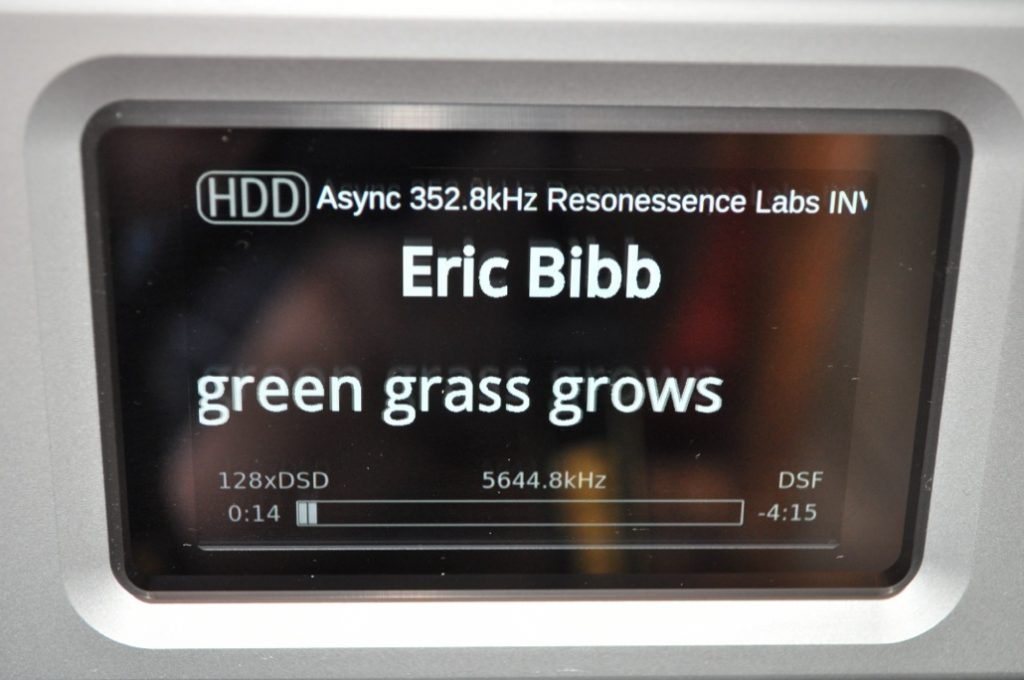
To flip things around and once again show Invicta is not merely a “forgiving” DAC, I grabbed what might possibly be my favorite recording ever – Eric Bibb’s “Where the Green Grass Grows” from his 1996 SACD release Good Stuff. Opus3 Records has this title available on one of their DSD Showcase collections, in DSD64 as well as DSD128, for a very reasonable price. Along with the Reference Recordings HRx Sampler, I definitely recommend these for building up a library of demo tracks.
As a quick aside, I’m surprised that we don’t already have most or all of the SACD catalog available as DSD downloads by now. DSD capable DACs are a big deal right now and these companies have been sitting on the rights to this stuff for years. The SACD market is essentially dead (no longer even a single pressing plant left in the USA) so you’d think everybody would jump at the chance to offer their back catalog in a new format – seems like minimal work for what could potentially be a bunch of new sales, on titles that probably haven’t made much money in years. So what’s the holdup? I see progress but it seems like it could have easily been completely done a year or two ago, when DSD DACs first started blowing up.
Anyway, enough of my rambling. Back to the musical experience – “Where the Green Grass Grows” is an excellent recording with great care taken during the process, including the use of “audiophile” equipment. It sounds great on CD and only gets better as it climbs the format ladder. As I play the DSD128 version on the Invicta Mirus and listen through my custom Kevin Gilmore Solid State High Voltage amp driving the Stax SR-4070 electrostatic earspeakers, it’s an experience that transcends just about anything else I’ve ever heard. So true to life, so convincing, you can close your eyes and just bathe in the experience. There’s not a single thing of the experience I’d change. Nothing. Yes, this song would be enjoyable even played on a portable AM radio, but the better the experience gets the more I connect with the music. The Invicta Mirus opens that door like no other DAC I know of.

Competition…
I happen to have several competing DACs here for direct comparison. The previously mentioned Esoteric D-07X costs just a few hundred dollars less than Invicta, and as I’ve already mentioned, it simply can’t keep up. There are times when I like what I hear from it, but it’s very tricky with system matching, and ultimately never reaches the same heights as the Resonessence Labs offering. I also have a Calyx Femto here, which costs nearly $2,000 more than Invicta. I find it similar in character to the Esoteric, though better to some degree. Still, it’s the same issue – etchy, bright sound, too much focus on details, and not enough “soul”. I can assemble a system around it that sounds really good but it still doesn’t compete with Invicta. And the pricing seem unrealistic considering the feature set involved. A good product, sure, but not a great one.
The closest match I have on hand is the Meitner MA-1. It too costs around $2,000 more than Invicta. But it comes a lot closer to matching the capabilities. I find it thoroughly enjoyable and would not hesitate to recommend it – except for the fact that Invicta Mirus beats it at its own game. The two sound fairly similar but with a few key differences. First, Invicta seems to have superior midrange articulation. The Meitner is no slouch, but I used it for quite a while without noticing that difference in the Marta Gomez albums. That says something. I feel more engaged, more connected with Invicta at the helm, though admittedly the difference is not huge. The other thing is the top end; I find the MA-1 very slightly reticent at times. Not dark, not rolled off in the least, but somehow less convincing with ride cymbals for example. It’s like the decay is slower and less well defined, making it feel somewhat less accurate overall. I probably wouldn’t ever notice without back to back comparisons though. Lastly, I felt the MA-1 sounded a little flat via the USB input – I consistently preferred it with the Audiophilleo 1/PurePower USB to SPDIF converter. That brilliant device used to improve the original Invicta as well, but with the Mirus upgrade and the continual improvements due to firmware updates, things have changed. Native USB is now just as good, if not better, than even the best DDC devices out there. This makes the Mirus an even better value since it requires nothing extra.
Odds and Ends…
Invicta works very well connected directly to a power amp; I used it to drive a Parasound Halo A21 as well as a pair of Ghent Audio M500P ICEpower monoblocks, and the results were indistinguishable from the Meridian G02 I had been using prior. If you find yourself dropping down to -80dB, then yeah, you’ll probably notice some thinning of the sound due to lost digital resolution. Keep things at medium to higher volumes though, and the so-called “DAC direct” method is extremely viable. Same deal with monoblock headphone amplifiers, which are all the rage these days (see examples HERE and HERE). The best way to run these types is to crank both amps to full blast and control volume through the DAC or preamp. Invicta handles this with aplomb, particularly with the Questyle CMA800R monoblocks paired with Sennheiser’s HD800. That’s probably the most accurate setup I’ve heard aside from my electrostatic system, and a large part of that credit goes to Invicta and it’s excellent preamp capabilities.
The USB and SD card inputs sound the best to me, with SPDIF options coming in a close second. This is good news as many DACs still sound best from a coaxial input, which is no longer the interface of choice now that computer audio rules the world. Interestingly, we get a Toslink output as well, which allows the SD card player to become a reference class transport to an external device. Seems like a somewhat useless feature if Invicta is really such a great DAC, but I was able to find a use for it. I paired it with the Unique Melody Platform Pure 6 which is a custom in-ear monitor with dedicated active amplification box. This setup extracted the most performance I’ve yet heard from the PP6, to the point where I’ve started using it far more now than ever before. The Toslink output isn’t a core feature but I still appreciate having it around.
Resonessence Labs offers a choice of 7 digital filters. Two of them are stock choices from the ES9018 chip, and the remaining five are custom made by the Resonessence crew. If you’ve ever played with digital filter selection on a DAC you probably know how the difference is small, and sometimes impossible to spot. I find these to have slightly more impact than those commonly found in, say, the Wolfson WM874x series, but it’s definitely still not a night and day difference. Still, I have my favorite (Linear-Phase Apodizing) and my alternate (Minimum-Phase IIR) and I’m happy to have the choice. It’s just one more area where Resonessence uses their expertise to craft something that most competitors omit all together, or else just rely on pre-existing options rather than innovating.The list of competing designers out there doing their own asynchronous USB code, with their own proprietary digital filters, and using their own DAC chips, is surely a tiny list indeed.
Conclusion…
Is there such a thing as a “perfect” DAC? Nope. Is there one that could be perfect for you? Absolutely. I’ve found mine in the Resonessence Labs Invicta Mirus. If you try it out, you just might agree. There are tons of DACs out there offering very good sound for less money than this – Resonessence has their own with the Concero HD at under a grand. But for an all-out assault on the state of the art the Invicta Mirus is the one as far as I’m concerned. Audition it at your own peril.
[separator type=”thick”]
The System…
My reference gear, for those interested in such things, is as follows:
APC S15 power conditioner
Aurender X100L music server
Audiophilleo 1 USB to SPDIF converter with PurePower option
YBA Design WM202 CD transport
A pair of Questyle CMA800R headphone amplifiers in monoblock mode
Auralic Taurus mkII headphone amplifier
Violecric V281 headphone amplifier
Icon Audio HP8 mkII single-ended triode headphone amplifier
Custom built KGSShv electrostatic amplifier
All cabling is Cabledyne Reference Silver
From there I have a small army of headphones: Stax SR-007mkII and SR-4070, Sennheiser HD800, Audeze LCD-3 and LCD-3, HiFiMAN HE-6 and HE-500, Mr Speakers Alpha Dogs, Noble Audio Kaiser 10, JH Audio JH13pro FreqPhase, Westone ES5, Unique Melody Platform Pure 6, and many others. Most headphones have aftermarket cables from Toxic Cables, Effect Audio, Charleston Cable Company, or Beat Audio.














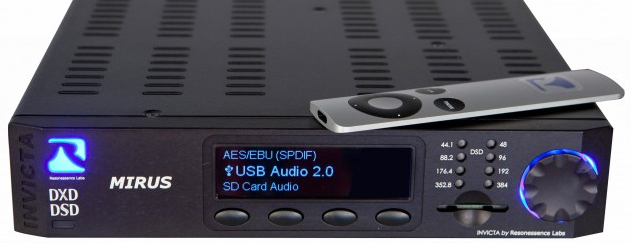
Reply
Reply
Reply
Reply
Reply
Reply
Reply
Reply
Reply
Reply
Reply
Want to join discussion?
Feel free to contribute!